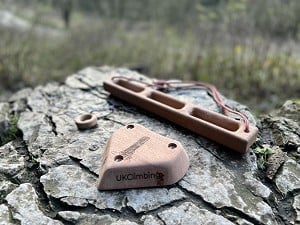
"As I said, finger strength is the key physical factor, but not the only. The data I have access to suggest that it accounts for around 20-30% of the factors that have influence over climbing level."
1980's Rockstar and climbing coach Chris Gore (still climbing strong) describes two new fingerboards and a training plan designed and based on research by the Spanish climber, Eva López.

"More power and greater endurance for only 1 minute a week!"
Catchy title, it certainly piqued my interest. So how true is it? We are always looking for that secret pill, that snake oil that will make us stronger, give us more power, greater endurance, help us lose weight and all without getting off the sofa.
As most climbers know there are no rewards without hard work and dedication, the Progression/Transgression hang boards are no different, you still need to dedicate yourself to a fixed plan and you need to be very strict in your approach to using these boards if you are to benefit.
So if your prepared to do the work, please read on: As you can see from the above photograph these hang boards are big, each of them has 8 edges; 10, 12, 14, 16, 18, 20 and 24mm deep and a 30mm top for warm ups on the Progression. The Transgression has 6, 7, 8, 9, 10, 12, 14, and 18mm deep with a 30mm hold on the top. The accuracy of the edges on these boards is stunning; I thought a 10mm edge was small but the 6mm edge will really need some strong fingers.
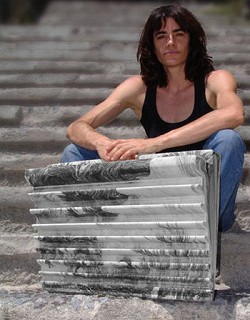
The hang boards and training plan are the brainchild of Eva López who is one of Spain's better known coaches and has developed specific training plans and methods over a number of years; the culmination of her research are these boards which are manufactured by JM Climbing, a Spanish company that designs climbing walls, holds and training aids.
JM Climbing's drive to developing tools using a scientific approach transformed what at first was an informal encounter with Eva into the culmination of her current research.
Eva is a herself an 8c climber (she's done four of them so no flash in the pan) and she trains many of Spain's top 9a climbers. The Progression and Transgression hang boards came about from Eva's Master's sports Science Degree and her eventual PHD studies.
Eva did her first studies in finger strength for her Master's degree in 2004 which provided the basis for her Trangression method; using added weight on big edges at first and then using small edges without added weight. A later study in 2010 compared the effects of three different maximum finger strength and strength-endurance training methods. She is currently combining all her research over the last decade for her PHD.
The training plan is based on High Intensity Training (HIT) which is now used in many sports and of course this can be applied to climbing. So how does dead hanging on edges reap such rewards?
I mentioned to Eva that back in the mid 80's a major focus for us (Chris trained with the likes of Jerry Moffat and Ben Moon) was dead hangs but we used to hang for 30 secs and rest for 30 secs, how does this differ from her regime of 10 sec hang and 3 minute rest.
In Eva's own words:
The time we grab a hold for during a key section of a climb oscillates between 5-15 seconds depending on the style (onsight, redpoint, competition); and the time we are not grabbing a hold is around 1-5 seconds (depending if we need to clip or not). So, apparently, this 30 seconds:30 seconds iterations would seem a bit long, especially for the hanging time, since it would force us to use fairly big holds; this probably would promote our endurance over big holds, but would hardly transfer to a fundamental quality: strength-endurance over small holds, and much less to maximum strength. In my training plan I suggest a method similar to what you mention (intermittent dead hangs), but using a higher absolute intensity and smaller holds, because the hanging time is 10 to 5 seconds.
This exercise (dead hangs) has a long history because, really, it made a lot of sense. People realized that climbing is an intermittent effort: grabbing and releasing holds. They also noticed they fell because they couldn't maintain their finger's grip position. The inference was to train something very similar in duration and gesture.
Because my experience as a climber and a coach, and the profuse bibliography I had already read as an aspiring researcher had taught me the following:
a) Finger strength is the key physical factor in climbing (disclaimer: not the only one!).
b) At the moment no published research looked into the effect of different methods of finger strength training in climbers.
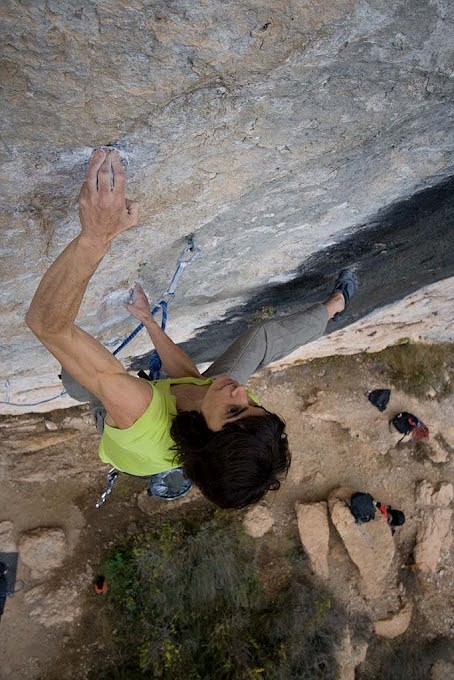
c) I could gather a small sample of high level (8a+/b redpoint average) volunteers to be the “guinea pigs” in the research project.
We started with some assumptions:
a) That the best exercise to specifically and measurably train finger strength were the deadhangs;
b) That part of climbing performance depends on the ability to hold very small edges; and
c) That a method for developing strength is the use of added weight. However recently I have observed that the lower level climbers can equally benefit from performing only the small edge method. This is because their body weight provides enough stimuli to induce gains; it is also in line with the recommendation of using at every stage the easiest method and intensity that still provokes adaptation to provide a sustained long-term development instead of a faster, short-term one.
One of the conclusions of that 2004 study was that by training first with added weight, and later without it but on smaller edges (which is a more specific exercise), there were gains in finger strength that in turn had a positive effect on finger strength-endurance.”
Some might consider the exercise limited, so does it work?
Two days of dead hangs per week are enough, but those who train for 5-6 days each week, they can add one extra dead hang session, always leaving 48-72 hours between them.
As I said, finger strength is the key physical factor, but not the only. The data I have access to suggest that it accounts for around 20-30% of the factors that have influence over climbing level. There are lots of additional physical factors, like pulling force, strength-endurance or explosive power. Technical-tactical factors, psychology, or having the resources to get enough rock climbing among many others can make a big difference but 20-30% for finger strength is a huge contribution.
As a final demonstration that this exercise contributes to the improvement of climbers, Eva puts forward some insights that are part of the thesis she is currently writing; she feels that the data analysis of her last research is still a work in progress but it gives you a good idea of the gains to be made.
She continues:
One group carried out the training of the first study:
- The participants with the lower level of finger strength experienced about 47% gain in finger maximum strength (maximum weight supported for 5 seconds on 15mm) and 40% in finger strength-endurance (maximum time on 11mm).
- The scores for those with a high level of finger strength went up 9% and 22% respectively.
Other group did intermittent dead hangs without added weight:
- The ones with the lower level of initial finger maximum strength went up by 25% in maximum strength and 65% in finger strength-endurance.
- In the higher strength subgroup the improvements were around 3% and 29%.”
Note how the lower level climbers experienced much greater gains; the stronger you are, the harder it gets, but that's hardly news, isn't it?
Read Eva
As an added bonus Eva has a blog and answers many questions on training – you can find her at en-eva-lopez.blogspot.co.uk
The suggested retail price of the boards is £200, they come ready mounted on plywood and ready to hang, the dimensions are 38cm x 58cm x 15cm, so you will need a good size area above a doorway to hang them.
Currently the Progression and/or Transgression hang boards are either available or will soon be available at Kendal Wall, The Depot in Leeds, Manchester Climbing Centre, Reading Climbing Centre other outlets or venues will available soon.
Please Note:
Progression is not recommended for people under 16 years of age.
Transgression is not recommended for people under 18 years of age.
Warning based on a study by Morrison and Schoffl
(2007): Physiological responses to rock climbing in young climbers. This study asserts there is a correlation between intensive finger training and the occurrence of serious injuries such as finger stress fractures in youths.
About Chris Gore
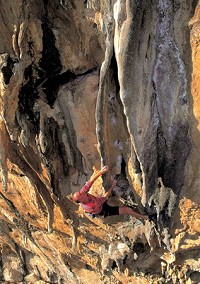
Chris Gore was one of the original lycra-clad 80's rockstars along with Jerry Moffat, Andy Pollitt, Ben Moon and Martin Atkinson. He is a well travelled climber and made the first ascents of Renaissance 8a at Malham, The Ogre 8a and Entree 8a in Chee Dale. He is still going strong on rock, and in other sports and lives in Kendal with his family.

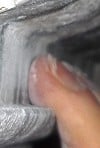

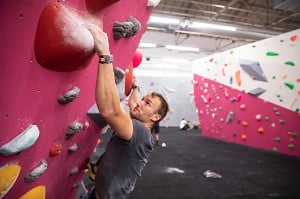
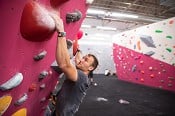
Comments